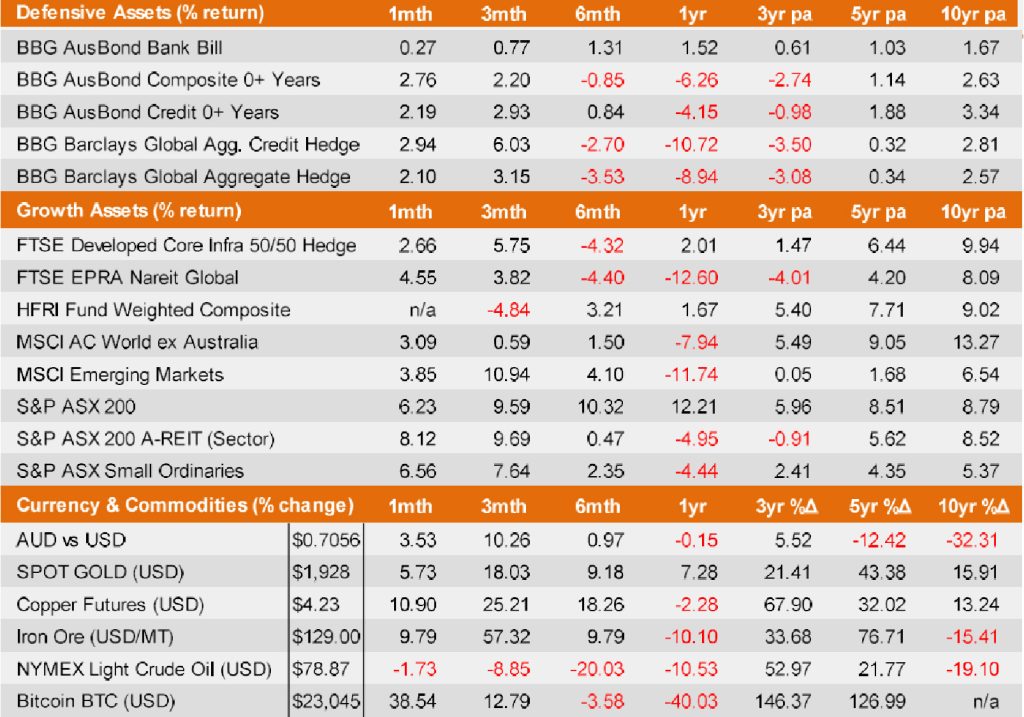Financial markets shook off the woes of 2022 to begin the year in spectacular fashion. A combination of falling bond yields, bullish sentiment and a short squeeze, set fire to the investment landscape. On the domestic front, the ASX 200 ended January 6.2% higher, to entirely recoup last year’s losses. Energy and Utilities, which outperformed in 2022, were the only two GICS sectors to post losses during the broad-based rally. Consumer discretionary was by far the strongest performer, up nearly 10%.
In US markets, the S&P 500 had its best month since October, while the Nasdaq 100 rallied the most since July, recording its best start to the year since 2001. Historically, a more than 5% gain in January for the S&P 500, following a negative year (as was 2022), tends to be a positive sign. Under those circumstances, on each of the previous five occasions, the full year has finished higher every time and by an average of 30%. As the rally gathered momentum, widespread short covering meant that several lower quality stocks were pushed higher, including those that lack positive earnings and have poor balance sheets. This is variously known as a ‘junk rally’ or ‘dash for trash’.
Among defensive assets, the closely watched US 10yr Treasury rallied strongly, driving its yield down to 3.52% by month’s end, having started the year at 3.83%. Elsewhere, copper and iron continued to rally, reflecting hopes that China’s reopening would provide a strong impulse to global growth.

Source: Evergreen Consultants, Financial Express, AUD total returns as at 31 January 2023.
Investment markets had a scintillating start to the year, with strong gains posted across the major asset classes. Developed market equities quickly shook off its December woes and the rally broadened as the month unfolded. Improving economic sentiment became more evident as calls for recession began to fade, with some analysts expecting the US Fed to pause its tightening agenda in coming months on slowing inflation.
Markets also happily ignored the poor tone of the Q4 earnings season that featured falling margins and ominous outlooks, but pointed to signs that revenue was often on par with the previous quarter. In US dollar terms, The S&P 500 was up 6.2% in January, bringing its one-year losses to 9.7%. The Dow Jones Industrial Average gained 2.8% for the month and was nearly 3% for the one-year period. Eight of the eleven S&P 500 sectors were up (compared with December 2022, when all eleven declined), with Consumer Discretionary leading the way. Its 15% gain comes after last year’s 38% thumping. Meanwhile Utilities lost 2%, after a decline in 2022 of less than 1.5%.
Elsewhere, cash returns continued to inch higher and markets priced for an additional hike in official rates after a stronger than expected inflation print. Bond markets also continued to fight back, following an atrocious 2022 where returns were the worst in modern history. Sovereign bond yields moved sharply lower and credit spreads remained tight throughout January. The risk-on environment pushed the Australian dollar higher against most currencies and breathed life back into Bitcoin, which finished the month nearly 40% higher.
On the domestic front, December quarter CPI inflation printed well above expectations, rising by 1.9% over the quarter and 7.8% through the year. More importantly, the underlying ‘trimmed mean’ measure of inflation came in at 6.9% for the year, easily exceeding the RBA’s 6.5% revised prediction. This led money markets to price for higher interest rates than previously and steepened the inversion recently observed at the front end of the domestic yield curve. Also, December’s retail sales fell a surprising 3.9% – the largest monthly fall since August 2020 – in a sign that November’s Black Friday sales continue to gain in significance. Finally, unemployment remained at 3.5%.
In the US, stronger than expected job gains and a fall in the unemployment rate to 3.5% in December, matched its 53-year low. Average hourly earnings rose by a less than expected 4.6%, a sign that price pressures are continuing to ease. Headline CPI fell to 6.4% in December, driven by falling energy and vehicle prices, and lower airline fares. In a worrying development, credit card debt rose by 15.2% across 2022, while the Leading Economic Indicators index breached levels over consecutive months that have always resulted in some kind of recession.
On the continent, the Eurozone Composite PMI surprised to the upside as sentiment improved. The relatively mild winter has calmed the energy crisis in Europe. Gas storage across the EU was still 75% full at the end of January, compared to 35% a year ago. The average purchase price for natural gas in January was 55% lower than the average over the second half of 2022. Finally, in Japan, its central bank kept the 0.5% cap for bond yields, surprising expectations of a higher yield target.
Disclaimer: This economic and market update has been prepared by Evergreen Fund Managers Pty Ltd, trading as Evergreen Consultants, AFSL 486 275, ABN 75 602 703 202 and contains general advice only.
It is intended for Advisers use only and is not to be distributed to retail clients without the consent of Evergreen Consultants. Information contained within this update has been prepared as general advice only as it does not take into account any person’s investment objectives, financial situation or particular needs. The update is not intended to represent or be a substitute for specific financial, taxation or investment advice and should not be relied upon as such.
All assumptions and examples are based on current laws (as at June 2023) and the continuance of these laws and Evergreen Consultants’ interpretation of them. Evergreen Consultants does not undertake to notify its recipients of changes in the law or its interpretation. All examples are for illustration purposes only and may not apply to your circumstances.